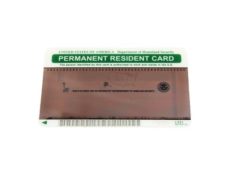
Getting a Green Card through Family
Obtaining a green card, also known as a permanent resident card, is a dream come true for many individuals and families who wish to live and work in the United States. A green card allows its holder to stay in the United States without the need for a visa or to worry about immigration status. Additionally, green card holders may be eligible to become a U.S. citizen, provided they meet the requirements established by U.S. immigration laws.
One of the most popular ways to obtain a green card is through family members who are either U.S. citizens or green card holders. Family-based immigration is a system that allows U.S. citizens and green card holders to sponsor certain family members for a green card. In this article, we will dive into the requirements, procedures, and steps that must be taken to get a green card through family sponsorship.
Family Categories In Family-Based Immigration
Family-based immigration is divided into two categories: immediate relatives and preferential family members.
Immediate relatives are spouses of U.S. citizens, unmarried children under 21 years of age of U.S. citizens, and parents of U.S. citizens who are 21 years or older. They are given the highest priority by U.S. immigration and do not have to wait for a visa number to become available. Immediate relatives can file for adjustment of status while residing in the U.S. or apply for an immigrant visa at a U.S. Consulate abroad.
Preferential family members, on the other hand, are divided into four subcategories, based on the age, marital status, and relationship with the U.S. citizen or green card holder. These subcategories and their priorities are as follows:
1. First preference (F1): Unmarried adult children of U.S. citizens;
2. Second preference (F2): Spouses, unmarried children under 21 years of age, and unmarried adult children of green card holders;
3. Third preference (F3): Married children of U.S. citizens; and
4. Fourth preference (F4): Siblings of U.S. citizens who are 21 years or older.
The visa bulletin published by the U.S. Department of State each month outlines the priority dates for each category. Priority dates, also known as cut-off dates, indicate the date when a visa application was filed, and the petitioner and beneficiary became eligible for permanent residency. Individuals must wait for their priority date to become current before they can apply for a green card.
Requirements For Sponsorship
To sponsor a family member for a green card, individuals must meet certain requirements. For U.S. citizens, they must be at least 21 years old, be a lawful permanent resident of the United States, and have enough income or assets to support their beneficiaries when they become permanent residents.
For green card holders, they must be at least 18 years old, have a U.S. domicile, which means they must live in the United States, and have enough income or assets to support their beneficiaries when they become permanent residents.
Additionally, sponsors must be U.S. citizens or green card holders and show that they have a familial relationship with the beneficiary. Sponsors must also prove that they are financially capable of supporting the beneficiary.
Procedures and Steps
The procedures and steps for sponsoring a family member differ depending on whether the beneficiary is already in the United States or outside of the country.
For beneficiaries already in the United States, the sponsor must file the appropriate application for adjustment of status with the United States Citizenship and Immigration Services (USCIS). In addition to the application, the sponsor must include supporting documents such as birth certificates, passports, marriage certificates, and evidence of financial resources. Further, the beneficiary must undergo a medical exam and obtain a police clearance certificate before submitting these documents to be reviewed by a USCIS officer.
If the sponsorship request is approved by the USCIS, the beneficiary may receive a notice to appear for an interview. The interview is a critical part of the process, and both the sponsor and beneficiary must attend. The officer will ask a variety of questions to ensure that the relationship is legitimate, and the beneficiary is admissible to the United States.
On the other hand, if the beneficiary is outside of the United States, the sponsor must file a Form I-130, Petition for Alien Relative, with the Department of Homeland Security (DHS). If USCIS approves the petition, it will be sent to the National Visa Center (NVC), where it will be processed, and a case number will be assigned. After which, the beneficiary will receive a notification for an interview appointment at the U.S. Consulate or Embassy in their country of origin.
The beneficiary must undergo a medical exam and obtain a police clearance certificate before the interview. The interviewer will ask a variety of questions to ensure that all the information provided in the petition is correct.
If the beneficiary is approved, they will receive their immigrant visa and can travel to the United States to become a permanent resident.
The Cost of Sponsorship
Sponsoring a family member for a green card can be an expensive undertaking. The fees associated with the application can vary depending on the type of application, whether it’s a consular processing or adjustment of status, and the age of the beneficiary. Here is an overview of the fees:
– I-130 Petition for Alien Relative: $535
– Application for Adjustment of Status: $1,225
– Medical Examination and Vaccinations: Varies by provider and location
– Police Certificate: Varies by country
– Consular Processing Fee: $325
– Diversity Visa Lottery Fee: Free
– Diversity Visa Application Fee: $330
Additionally, there may be additional legal and filing fees associated with the process, which can add up to several thousand dollars.
Conclusion
Getting a green card through family sponsorship can be a challenging and time-consuming process, but it can be an excellent way for individuals and families to have legal residency in the United States. It’s important to have a clear understanding of the requirements, procedures, and steps needed to file a successful petition.
Individuals who wish to file a petition should aim to obtain up-to-date information from reliable sources such as the USCIS and the Department of State before proceeding. It’s also crucial to hire a qualified immigration attorney to guide you through the process and increase your chances of a successful application.
At the end of the day, family-based immigration is a vital component of U.S. immigration laws, and it offers opportunities for individuals to reunite with their loved ones and contribute positively to the country. While the process may be time-consuming and costly, it’s an investment in the future of individuals and their families.
What does ‘Green Card through Family Mean?’
A large quantity of United States’ citizens becomes permanent residents through their family members. The United States’ government promotes family unity and permits U.S. citizens and permanent residents to petition certain relatives to come and live permanently in the United States.
There are two distinct avenues to obtain a green card; many family members who already reside in the United States may qualify for an adjustment of status to permanent residence in the United States. This adjustment means that the applicants are able to complete the immigration process without returning to their home country.
Relatives who live outside the United States, or those individual who do not qualify for an adjustment of status may be eligible for consular processing through a U.S. embassy or consulate abroad.
Methods of Receiving a Green Card through Family
An applicant may be eligible to obtain a green card as an immediate relative or as a family member in a preference category if the U.S. citizen relative files a Form I-130, or the petition for Alien Relative.
An individual is regarded as immediate relative of a U.S. citizen if they are a child (unmarried and under 21 years of age) of a U.S. citizen, if they are a spouse (husband or wife) of a U.S. citizen, or if they are a parent of a U.S. citizen.
Family members of a U.S. citizen in a preference category include: an unmarried son or daughter (21 years or older) of a U.S. citizen, a married son or daughter (any age) of a U.S. citizen, and a sibling (brother or sister) of a U.S. citizen.
The requirement for the receipt of a Green Card through Family is fairly uniform with regard to the classification of an approved immediate family member, circumstances surrounding contingencies and extraordinary conditions can exist:
a. A birth that took place outside of the borders of the United States – with regard to parents who are legal citizens of the United States –retains the possibility of awarding United States citizenship through naturalization to the children birthed; however, this will typically require that the child resides within the United States on a permanent basis
b. Prior to the receipt of a Green Card through Family, individuals will first be required to apply for the appropriate Visa; this will allow them to remain within the United States pending the Green Card application process
Applicable Forms for Receiving a Green Card through Family
Form I-485: The adjustment of status application form changes the temporary legal status of a non-citizen to legal and permanent residential status
Form I-130: Relatives of the non-citizen spouse – or any relatives who are not citizens of the United States and married children or children exceeding the age of 21 of the non-citizen/U.S. citizen marriage must complete an I-130 petition in order to be considered to for legal, permanent resident status as a result of this type of marriage. In most cases, a K-3 or K-4 Visa can be acquired in order to permit legal residence during the processing of this form, which is granted on a temporary basis
Form G-325A: This form must be completed by all individuals petitioning for the receipt of a Green Card through Family




























